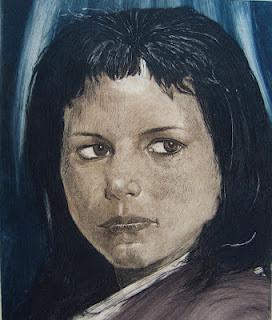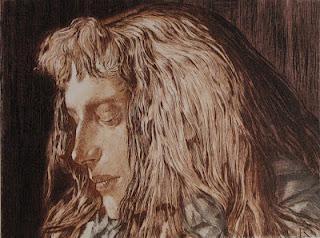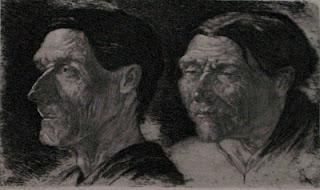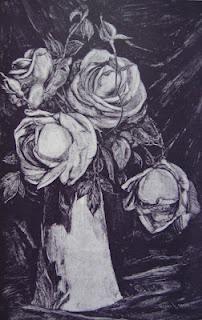 Ernst Klotz, ZigeunerknabeEtching, 1895
Ernst Klotz, ZigeunerknabeEtching, 1895 Ernst Klotz, MädchenkopfEtching, 1895
Ernst Klotz, MädchenkopfEtching, 1895 Ernst Klotz, Zwei StudienköpfeEtching, 1895
Ernst Klotz, Zwei StudienköpfeEtching, 1895Like many Jugendstil artists, Ernst Klotz made no firm distinction between art and craft. He made designs for metalwork, furniture, and interiors, but his chief interest was in printmaking and graphic techniques. In the 1890s Ernst Klotz developed a new method of printmaking, in which the image is painted onto a metal plate, and engraved directly from this original artwork. He called this planographic technique malertypie. I confess I do not fully understand how it worked; it seems to be a cross between etching and lithography, and the finished results look more like a litho than anything else. It appears to have been a versatile, painterly technique, which had the advantage of producing a plate as durable as a conventional letterpress plate. However it did not catch on, and so far as I know the only artists to use it were Klotz himself and two of his associates, Thomas Theodor Heine and Oscar Leonhard Geyer. I don't have a malertypie by Klotz, but some can be seen on the website of the Leipzig Museum (if you can make the website work, which I have found difficult with Safari). I do have an example of a malertypie by Geyer, entitled Blumenstück: Studie in E. Klotz' Malertypie. This was published to accompany an article on the technique in Zeitschrift für Bildende Kunst, Neue Folge IX, 1898, entitled Eine Neue Graphische Technik.
 Oscar Leonhard Geyer, Blumenstück: Studie in E. Klotz' MalertypieMalertypie, 1898
Oscar Leonhard Geyer, Blumenstück: Studie in E. Klotz' MalertypieMalertypie, 1898Because he worked simply as E. Klotz, a great deal of confusion has arisen around Ernst Klotz's etchings, with many museums and galleries attributing them wrongly to the Austrian sculptor Edmund Klotz, as I did when I originally posted the etching of the gypsy boy. I have to thank Erika Esau, the librarian at the Robert Gore Rifkind Center for German Expressionist Studies at the Los Angeles County Museum of Art for her help in sorting out the muddle.

